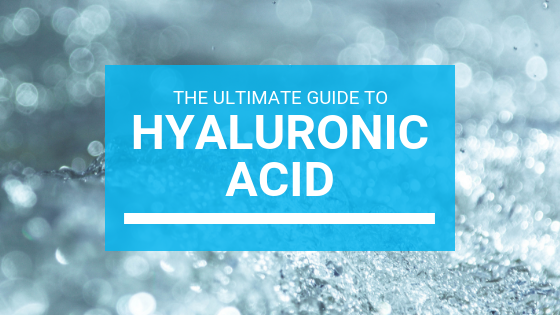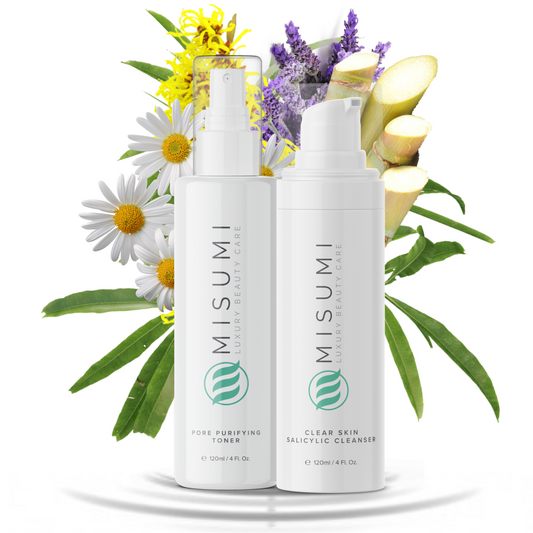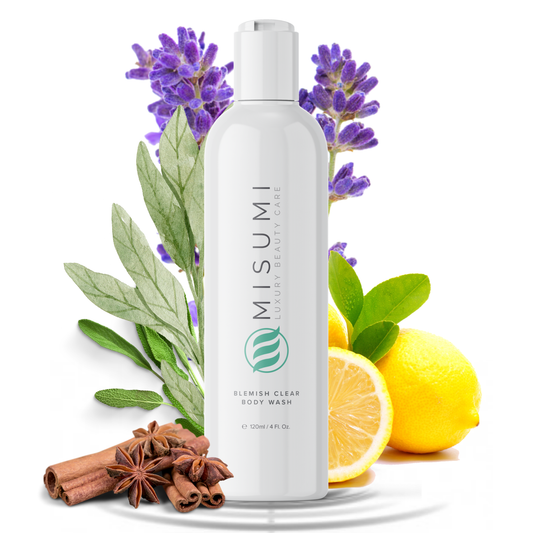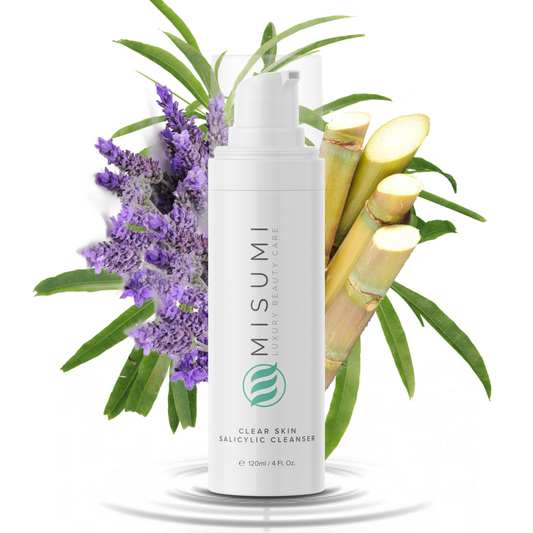For people dealing with acne, hyaluronic acid (or HA) has almost become a beauty world buzzword now - you probably keep hearing it everywhere. Everyone praises the powers of this magical serum. And it always seems to go hand in hand with images of picture-perfect models with their lightened skin and glowing faces.
It might sound alluring and powerful, but what is it? Can HA help you get rid of acne for good? Is hyaluronic acid really that powerful, or are you just being fooled by the power of advertising?
We decided to check for ourselves, and this is the result. Welcome to our ultimate guide for hyaluronic acid.

What is Hyaluronic Acid?
As with salicylic acid, the name sounds a bit intimidating. An acid? What kind of acid, and why would anyone be willing to put acid on their face? After all, acids are known to cause burns, not moisturized skin.
But rest easy. The "acid" part in hyaluronic is a misnomer. The ingredient has a neutral pH value, and natural levels of it are produced in our bodies. Its main function is to attach itself to water molecules and act as a lubricant.
Initially, hyaluronic acid was referred to as "goo," because it was translucent and slippery. It can be found in the insides of our eyeballs, as well as between our joints, but also in the structure of our skin.
There, hyaluronic acid works as a glue, connecting the molecules of collagen and water and keeping them together. Collagen, one of the building blocks of our skin, plays the main role in its elasticity and appearance. By pairing it with water, HA acts as a powerful natural hydration agent, making your skin moist and fresh.
This makes HA one of the best "natural" moisturizers. The hyaluronic acid your body creates binds itself to the molecules in your skin, giving it an elastic, full, smooth, dewy quality. The average adult person of around 70 kilograms (or 154 lb), is considered to contain around 15 grams of hyaluronic acid in their body. A full third of this amount is recycled each day, which sometimes creates the need for external supplementation.

This makes your skin take on a pleasant, youthful glow, which is why HA is often used in skin-lightening products.
And not just that - hyaluronic acid serum is nowadays the main ingredient in many skincare products. It's found in moisturizing creams, gels, moisturizers, serums, face washes, salt form, and even beauty masks. So it's easy to implement it into your skincare routine to achieve hydrated skin.
Why Do We Need Extra HA?
Good question, right? Why would we need all those products boasting of their rich contents of HA when our bodies make it themselves? Well, there's a catch.
You see, entropy is one of the fundamental properties of nature, and it expresses itself in living organisms through aging. As we age, our bodies gradually lose efficiency and functionality, resulting in losses of collagen and hyaluronic acid, too - thus, the loss of moisture.
All of that combined makes our skin less fresh and supple, and more vulnerable, causing wrinkles and fine lines.
Harsh weather, be it scorching summers or freezing winters, have a harmful effect on our skin, making moisture retention difficult. We may not be able to see it, but all that expansion and contraction that our skin goes through due to temperature differences inflicts microscopic cracks. And guess what these cracks do? They either make your molecules evaporate, or freeze and burst, causing that winter redness you see on your skin when you go outside.

Those processes hamper your body's natural ability to bind molecules within its skin to ensure optimal freshness and elasticity. The collagen becomes destroyed, the HA becomes recycled, and can't keep up with all the damage your skin is going through. You'll need additional moisture to combat skin aging and drying.
The solution?
The powerful moisturizing effects of hyaluronic acid products. The additional HA will trap all those loose molecules floating around and resurrect your skin.
Should I Use Hyaluronic Acid?
You may have learned through experience that not every new, hyped-up product is good for you.
So is hyaluronic acid safe?
The answer is yes - you can use hyaluronic acid for skin health, regardless of your skin type. (Yes, those of you with sensitive skin, too!) Use hyaluronic acid to treat acne and regain moisture lost.
This powerful moisturizer is one of the few substances popular in the skincare industry that won't cause allergic reactions or irritation. This kind of makes sense when you consider it a substance our bodies produce naturally, right?
However, it always pays off to test any substance before using it. To ensure a substance won't cause irritation, allergies, or injuries, perform a patch test. If you don't experience any side effects, add the product to your skincare routine. But if you do, stop using it immediately.
If a reaction happens, it's probably not the HA causing it. Skin care products and beauty products come packed with dozens of ingredients, so chances are that your skin is reacting to another ingredient found in the product. At any rate, wash the area, and visit your dermatologist, or doctor, to figure out what caused the reaction.
Not everyone will see the same benefits from applying hyaluronic acid to their skin. People with dry skin see the greatest improvements after using HA. Their skin has seen the most damage, so it makes sense that the effects of the hyaluronic acid product will be the most visible in their case.

As we mentioned above, older people will find HA especially useful. This is because their skin is not as moisturized and elastic as when they were young. They could use a boost of hyaluronic acid to recapture the water molecules and create more moisture. When applied topically, a hyaluronic acid serum will help those with dry skin retain moisture, ensuring they regain that freshness and elasticity.
But this doesn't mean you won't be able to harness the properties of hyaluronic acid serums if you don't fall in either of those two categories. People with normal or oily skin, or even sensitive and combination skin types, will find hyaluronic acid useful.
Younger people can benefit from it, too, because the same applies to them. Sometimes you need that additional boost.

Hyaluronic Acid Products
You've probably seen the commercials. Sometimes they offer hyaluronic acid in the form of a really good cleanser. Other times it's a hyaluronic acid moisturizer, gel, cream, facial mist, tincture, mask, or serum, and sometimes it's a large bottle of clear liquid. But this acid can also be administered invasively, with the help of a needle under the skin.
How to Use Hyaluronic Acid Topically
Topical products are applied on the skin's surface. You don't need to eat it, drink it, or stab yourself with it. Topical HA serum is the perfect product for retaining moisture and achieving glowing, plump skin.
You use your hands to apply hyaluronic acid serum over your skin. Always check whether you should apply hyaluronic acid to damp skin or dry.
Lucky for everyone, this means you can buy the vast majority of products that contain this acid over the counter.

Hyaluronic Acid Buyer’s Guide
Now that we've cleared that up, let's discuss which products work best.
Roughly two kinds of hyaluronic acid are offered in most skin care products, one being the so-called "pure" hyaluronic acid serum. And while both are good, that's not what determines their effectiveness.
Knowing what to look for in a product containing hyaluronic acid can make all the difference. If you have a tool but don't use it right, it won't be effective. So a short buyer's guide for hyaluronic acid products is a must.
Hyaluronic Acid And Molecular Weight
When judging how effective hyaluronic acid will be for your skin, it all comes down to the molecular weight of the hyaluronic acid formula. The lighter the weight, the smaller the HA molecules. As a result, they will be able to penetrate deeper layers of your skin, inducing plump, hydrating goodness. However, don't just go for the lower molecular weight products, but a combination of various molecular weights.
Why? Because your skin isn't identical in all areas. Smaller hyaluronic acid molecules work well for some areas of the skin, but other areas have larger microscopic gaps, which is why you will need some heavier HA molecules too.
So, a combination of low and high molecular weights of hyaluronic acid will maximize its effectiveness. This information should be visible on the product's packaging and composition, so read up to avoid wasting money.

Be Sure To Get Your Hands On Some Sodium Hyaluronate Too
Okay, so molecular weight, got it. But is there anything else?
Besides looking to optimize the effects of hyaluronic acid by ensuring it comes in a variety of molecular masses, be on the lookout for sodium hyaluronate. If you don't know what that is, it's simple.
Sodium hyaluronate is a type of salt made from hyaluronic acid. It has the same benefits, with the bonus of being more easily absorbed. As with hyaluronic acid, this offshoot, derivative salt of the acid, called sodium hyaluronate, is completely safe to use.
So, if you want to kick your hyaluronic acid into high gear, ensure the products you use contain both hyaluronic acid and sodium hyaluronate. Of course, don't forget about getting those diverse molecular masses too. Taking all these factors into consideration when shopping for hyaluronic acid skin care products can be a lifesaver.

Hyaluronic Acid Fillers
Hyaluronic acid is used in the application of fillers by way of a syringe or otherwise. Getting a filler is a common and safe procedure nowadays, so there's no reason to worry.
For example, hyaluronic acid is often used in dermal fillers. For this purpose, it's used as a clear gel. It's injected under the skin, and, once administered, it binds to the water from the surrounding tissue. This helps the surface of the skin and the tissue below it to smooth out. Hyaluronic acid helps rebuild lost tissue and skin structure, which will ultimately smooth wrinkles and tighten saggy areas, making for younger-looking skin.
For your safety, follow the Food and Drug Administration's guidelines and list of approved hyaluronic acid fillers. At the moment of writing this, the approved hyaluronic acid fillers by the FDA are Belotero, Juverdem, Restylane, Restylane Silk, Restylane Lyft, Restylane Refyne, Restylane Defyne, Vollure, Volbella, and Voluma.

Not All Hyaluronic Acid Fillers Are The Same
Fillers are used to remove or tighten flat areas of skin. Other applications of hyaluronic acid fillers include the filling up of marionette lines (those curves that run from the corners of your mouth down along your chin) and the nasolabial folds (the line between the upper corners of your mouth to the outer corners of your nose). Additionally, they can augment the cheeks, the areas under the eyes, the lips, and even the dorsal areas of your hands.
However, a filler intended to fill the dorsal area of the hands will not be the same as the filler for the lips. While the general composition remains the same, i.e., hyaluronic acid, the intended function of each filler makes for important structural differences.
The molecular weight, as well as how the hyaluronic acid molecules are attached together, affect the gel's density and lift-ability. Some hyaluronic acid fillers are stiffer and more weighty but hold more water. On the other hand, other fillers have a softer, more pliable structure and are better suited to treat features on the surface of the skin.

Are Hyaluronic Acid Fillers Reversible?
Hyaluronic acid is natural but also completely reversible. Sometimes things go wrong, and the filler can block out important blood vessels, compress nerve endings, or it may just look bad. In any case, regardless of the reason, hyaluronic acid fillers can be easily reversed. All your dermatologist needs to do is inject a bit of an enzyme called hyaluronidase into the filler. The hyaluronic acid will quickly react to this enzyme in its midst and can dissolve in minutes.
For better results, you should allow anywhere from 24 to 48 hours. Dermatologists advise caution when deciding to dissolve a hyaluronic acid filler. The enzyme we mentioned above, hyaluronidase, is present in bee venom. This means it can cause an allergic reaction in people with bee sting allergies. So, if you're allergic to bees, avoid hyaluronic fillers.
Pregnant Women Should Avoid Hyaluronic Acid Fillers
While there's no hard data to prove the harmfulness of this hyaluronic acid treatment for pregnant women, dermatologists avoid the scenario. Simply, since hyaluronic acid is very reactive to water and molds surrounding tissue, it can lead to fetal malformations if it reaches the embryo or the fetus.
It is for this purpose that pregnant women should not be getting hyaluronic acid fillers. Just wait it out, ladies! Once you bring the baby into the world, fill away.

Hyaluronic Acid Fillers Are Not Recommended For People With Skin Infections
The same goes for people struggling with a skin infection or another skin condition. The injection of hyaluronic acid can lead to complications and unforeseen consequences.
Besides, it can be completely counterproductive. Why get a filler if your skin is still beset with acne? The acne will undo any repair the hyaluronic acid filler will do.
So, deal with the skin condition first, and use the hyaluronic acid filler later. You'll find incorporating hyaluronic acid in its topical form (such as a HA serum) much more beneficial.
Other Things to Avoid When Getting a Hyaluronic Acid Filler
Blood thinning agents such as ibuprofen or aspirin can mess up the filler and cause excessive swelling, bruising, and bleeding, slowing down wound healing. So, it's best to stop taking those medications for a while or delay taking the filler.
Interestingly, wine can have much the same effect.
Other substances, like bromelin or arnica, can counter this to an extent and decrease any swelling and bruising. But it's always the better choice to stop drinking wine or taking aspirin or ibuprofen for at least a week before getting your hyaluronic acid fill. It's better to be safe than sorry.

Summary
Your skin deserves to bask in the many benefits of hyaluronic acid. HA brings moisture to dry skin, and it's one of the most effective and harmless substances in the skincare industry. That makes the reputation of this acid well-earned, even compared to its competitors (such as glycolic acid).
Being naturally produced, HA is still routinely recycled by our bodies, which can reduce its amounts and effectiveness. Supplementing it with a quality hyaluronic acid product can greatly help. It's suitable for all skin types, although people with dry skin, adults, and the elderly need it the most to attract moisture.
When considering which hyaluronic acid product to purchase, keep an eye on its molecular weight and check if it contains sodium hyaluronate. Using hyaluronic acid that comes in various molecular weights is the best since this will maximize the absorption of the product in the skin. The same goes for sodium hyaluronate, providing you with an additional boost.
For the brave souls out there, getting hyaluronic acid fillers is also an option. There are various hyaluronic acid products on the market; the safest ones are those approved by the FDA.
Depending on their intended use, hyaluronic acid fillers come in different structures and compositions and are completely reversible and usually harmless. However, pregnant women, people with a skin condition, or people allergic to bee venom should steer clear. But for everyone else...
Who needs Instagram filters when you have hyaluronic acid?
References
Hyaluronic acid: A key molecule in skin aging
This information is meant to supplement, not replace advice from your doctor or healthcare provider and is not meant to cover all possible uses, precautions, interactions or adverse effects. This information may not fit your specific health circumstances, and its goal is to offer a general view of the subject. In case you are suffering from a severe case of acne, you should consult with a dermatologist or a certified medical professional.









